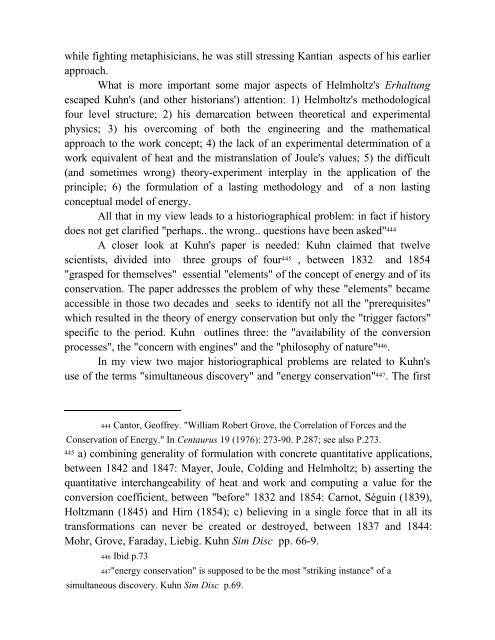Conservation and Innovation : Helmholtz's Struggle with Energy ...
Conservation and Innovation : Helmholtz's Struggle with Energy ...
Conservation and Innovation : Helmholtz's Struggle with Energy ...
You also want an ePaper? Increase the reach of your titles
YUMPU automatically turns print PDFs into web optimized ePapers that Google loves.
while fighting metaphisicians, he was still stressing Kantian aspects of his earlier<br />
approach.<br />
What is more important some major aspects of <strong>Helmholtz's</strong> Erhaltung<br />
escaped Kuhn's (<strong>and</strong> other historians') attention: 1) <strong>Helmholtz's</strong> methodological<br />
four level structure; 2) his demarcation between theoretical <strong>and</strong> experimental<br />
physics; 3) his overcoming of both the engineering <strong>and</strong> the mathematical<br />
approach to the work concept; 4) the lack of an experimental determination of a<br />
work equivalent of heat <strong>and</strong> the mistranslation of Joule's values; 5) the difficult<br />
(<strong>and</strong> sometimes wrong) theory-experiment interplay in the application of the<br />
principle; 6) the formulation of a lasting methodology <strong>and</strong> of a non lasting<br />
conceptual model of energy.<br />
All that in my view leads to a historiographical problem: in fact if history<br />
does not get clarified "perhaps.. the wrong.. questions have been asked" 444<br />
A closer look at Kuhn's paper is needed: Kuhn claimed that twelve<br />
scientists, divided into three groups of four 445 , between 1832 <strong>and</strong> 1854<br />
"grasped for themselves" essential "elements" of the concept of energy <strong>and</strong> of its<br />
conservation. The paper addresses the problem of why these "elements" became<br />
accessible in those two decades <strong>and</strong> seeks to identify not all the "prerequisites"<br />
which resulted in the theory of energy conservation but only the "trigger factors"<br />
specific to the period. Kuhn outlines three: the "availability of the conversion<br />
processes", the "concern <strong>with</strong> engines" <strong>and</strong> the "philosophy of nature" 446.<br />
In my view two major historiographical problems are related to Kuhn's<br />
use of the terms "simultaneous discovery" <strong>and</strong> "energy conservation" 447. The first<br />
444 Cantor, Geoffrey. "William Robert Grove, the Correlation of Forces <strong>and</strong> the<br />
<strong>Conservation</strong> of <strong>Energy</strong>." In Centaurus 19 (1976): 273-90. P.287; see also P.273.<br />
445 a) combining generality of formulation <strong>with</strong> concrete quantitative applications,<br />
between 1842 <strong>and</strong> 1847: Mayer, Joule, Colding <strong>and</strong> Helmholtz; b) asserting the<br />
quantitative interchangeability of heat <strong>and</strong> work <strong>and</strong> computing a value for the<br />
conversion coefficient, between "before" 1832 <strong>and</strong> 1854: Carnot, Séguin (1839),<br />
Holtzmann (1845) <strong>and</strong> Hirn (1854); c) believing in a single force that in all its<br />
transformations can never be created or destroyed, between 1837 <strong>and</strong> 1844:<br />
Mohr, Grove, Faraday, Liebig. Kuhn Sim Disc pp. 66-9.<br />
446 Ibid p.73<br />
447"energy conservation" is supposed to be the most "striking instance" of a<br />
simultaneous discovery. Kuhn Sim Disc p.69.
















